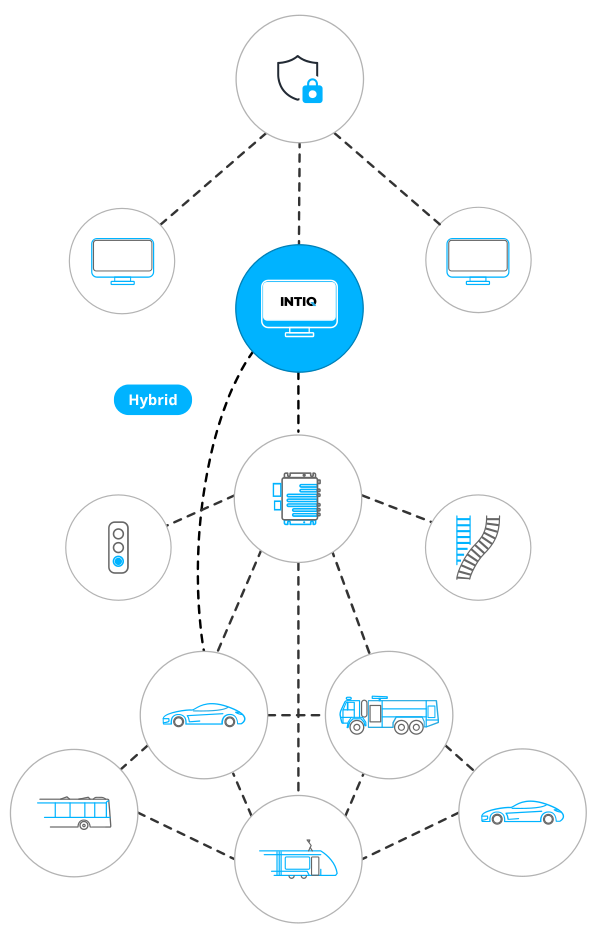-20˚C to +60˚C
Cooperative Intelligent Transport Systems
C-ITS covers the standardized communication of vehicles with each other and with the infrastructure, regardless of their manufacturer. This makes traffic safer and smoother.
C-ITS is widely considered a necessary step towards autonomous mobility. It is a decentralized, completely modular ecosystem that already brings many benefits today.

How it may help your city
Makes public transport effective
by deploying public transport preference on signalled intersections
Saves lives
by providing emergency and law enforcement vehicles a priority pass-thru on signalled intersections
Our reference: Mladá Boleslav
Informs about your surroundings
by providing information about the type, current location, speed and a heading of surrounding traffic, pedestrians and other non C-ITS enabled objects
Informs drivers
by automatically publishing information about planned or unplanned roadworks, stationary vehicle locations or even unexpected weather events
Our reference: C-ITS Backoffice for Road and Motorway Directorate
Exchanges traffic data
by subscribing and publishing of selected traffic and infrastructural data to public transport companies, city organizations, other cities, central government or your citizens
C-ITS ecosystem
Integration Platform and PKI
Traffic Management centres
Road-side units
On-board units
Mobile apps Verification Suite

Integration Platform and PKI
Traffic Management centres
Road-side units
On-board units
Mobile apps Verification Suite

C-ITS Backoffice
Backoffice manages all connected C-ITS units of all types and effectively transmits C-ITS messages between them even if they can’t reach each other using direct short range radio communication. That creates a hybrid concept which keeps C-ITS systems up and running thanks to independent communication channels. The data flows automatically.
However, an operator of the traffic control centre can manually enter events such as roadworks, lane closures or weather warnings.
Data collected by the C-ITS Backoffice is used across other modules like Traffic.
Traffic module provides analytic inputs such as journey times which can be provided to road users in the form of IVI (In-Vehicle Information) messages.
Used by municipalities, road authorities and public transportation companies.
Compliant
Versatile
User friendly
Durable
Talkative
Compatible
Open
Secure
Integration platform synchronizes events between different C-ITS systems.
This allows an individual ecosystem (C-ITS cluster) to work with information provided by different ecosystem, legacy systems and traffic centres.
Integration platform saves money by reducing the need for costly, case-by-case custom integrations.
.png)

Public Key Infrastructure (PKI) is a central part to manage cryptographic keys and authorization tokens. It is an essential part of C-ITS security.
All transmitted messages are protected by keys signed by PKI and so enrolled system parts can trust each other even without network connection.
PKI is customized for the specific requirements of C-ITS systems as specified by ETSI standards.

C-ITS Verification Suite enables users to independently verify behaviour of any C-ITS system for compliance and compatibility.
Suite is useful for development purposes as well as for functional verification before or during the actual deployments.
Verification Suite is available as a set of testing hardware and a cloud service. It can be configured to broadcast messages to be processed by the tested equipment.
Suite allows to manage testing scenarios and run them as many times as required. During the testing it continuously receives and evaluates messages sent by the equipment under test. Full testing history is also available.
This helps test management to keep track of tests, their results and progress in different stages of testing or C-ITS deployments.

Up-to-date
Compatible
Independent
European
Vehicle and infrastructural unit
C-ITS unit INTENS SmartGear R4 may act as an on-board (OBU) or infrastructure (RSU) unit and so it covers whole range of traffic scenarios.
The unit is fully certified for use in road and railroad vehicles such as trams or trains and offers wide range of interfaces for integration to various on-board systems.
Our hybrid communication feature means that the unit uses ITS-G5 radio
for short range communication, as well as LTE or 5G to connect directly to its C-ITS Backoffice or units which do not support ITS-G5. Thus it is more durable, compatible and fully ready for the wireless future.

177x125x38 mm
10-95% (non-condensing)
920 g
- CPU 4x Cortex-A53 1.8 GHz
- 4 GB RAM
- eMMC 32 GB built-in
- eSIM and physical SIM slot
- 1Gbps Ethernet
- 7x SMA (WiFi, 2x cellular, 2x V2X, 1x GNSS)
- Ethernet M12
- General purpose inputs
- USB 2.0
- EMC (Electromagnetic Compatibility)
- Vibration test
- Electrical safety
- Atest 8SD (E8)
- EN 50155
Unit is typically used to enable C-ITS features to non-C-ITS enabled public transport and emergency vehicles (OBU mode), as well as infrastructure unit (RSU mode) to cover areas with C-ITS features.

HMI application for mobile phones and tablets displays received C-ITS messages relevant for the driver and so it serves as the user interface.
It is typically used as a demonstration tool, but the core of the app can be embedded into any existing applications used in your city or country to bring C-ITS features to your citizens and visitors.
Experience
Sharing
Discovery
Compatibility
Relevance
Unlimited
